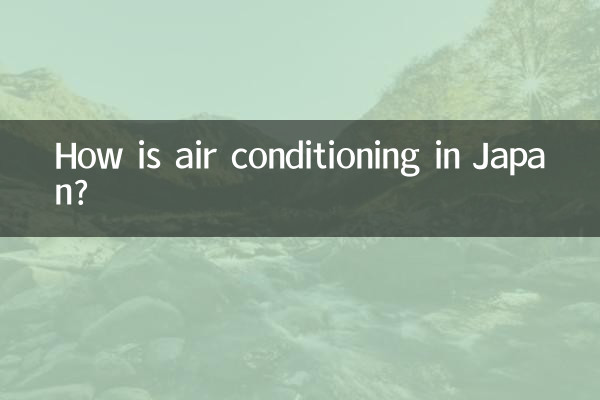How is air conditioning in Japan?
In recent years, Japanese air conditioning products have attracted the attention of consumers around the world due to their high energy efficiency, intelligent design and excellent user experience. This article will combine the hot topics and hot content on the Internet in the past 10 days to give you a detailed introduction to the characteristics, advantages and market feedback of Japanese air conditioners.
1. The core advantages of Japanese air conditioners

Japanese air conditioning brands such as Daikin, Panasonic, Mitsubishi Electric, etc. are known for their technological innovation and quality. Here are its main advantages:
| Advantages | Description |
|---|---|
| Energy saving and efficient | Japanese air conditioners generally use variable frequency technology, which can automatically adjust power according to room temperature and has significant energy saving effects. |
| Silent design | The operating noise is as low as 20 decibels, which is suitable for users who have high requirements for a quiet environment. |
| Intelligent functions | Supports APP remote control and voice assistant linkage, and some models have air purification functions. |
| Durability | The average service life of Japanese brand air conditioners can reach more than 15 years, and the failure rate is low. |
2. Recommended popular Japanese air conditioner models
According to e-commerce platform data and user reviews in the past 10 days, the following models have attracted much attention:
| brand | Model | Features | Price range (RMB) |
|---|---|---|---|
| Daikin | FTXR336UC-W | First-level energy efficiency, nano water ion purification | 6000-8000 |
| Panasonic | CS-RE9RKR | ECONAVI energy-saving navigation, except PM2.5 | 5000-7000 |
| Mitsubishi Electric | MSZ-ZFJ12VA | Dual-rotor compressor, extremely fast refrigeration | 7000-9000 |
3. User evaluation and market feedback
Through research on social media and e-commerce platforms, Japanese air conditioners have high user satisfaction, but there are also some controversial points:
| Evaluation dimension | positive feedback | negative feedback |
|---|---|---|
| Performance | Fast cooling/heating speed and stable temperature | Some models have average heating effect in low temperature environment |
| price | High-end models are good value for money | The entry price is 30%-50% higher than that of domestic air conditioners. |
| After-sales service | Professional installation team service specifications | Maintenance response in remote areas is slow |
4. Suggestions on purchasing
1.Choose based on budget: The price of air conditioners in Japan is generally high, and it is recommended that users with sufficient budget give priority to them.
2.Pay attention to energy efficiency ratio: Choose first-class energy-efficiency products to save energy during long-term use.
3.Functional requirements: If you need additional functions such as air purification, you can choose the corresponding model.
4.Installation environment: Old houses need to confirm the circuit load and installation space in advance.
5. Future development trends
According to industry analysis, Japanese air conditioning brands are developing in the following directions:
-More environmentally friendly: Use environmentally friendly refrigerants such as R32 to reduce carbon emissions.
-Smarter: Popularization of AI temperature control algorithms and human body sensing technology.
-health function: Enhanced sterilization and virus removal functions will become standard.
Generally speaking, Japanese air conditioners are still in the leading position in the industry in terms of technology, quality and user experience, and are a good choice for consumers who pursue high-quality life. However, when purchasing, you need to consider factors such as budget and actual needs to choose the product that best suits you.

check the details

check the details